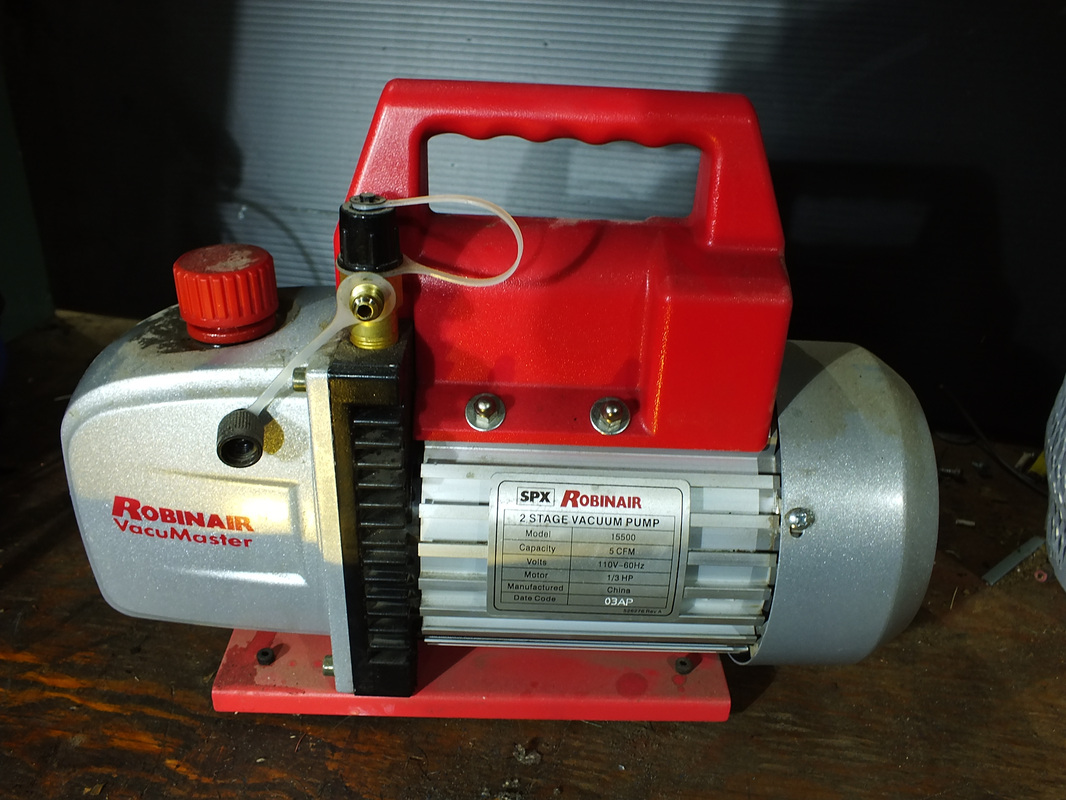The vacuum pump
Why use the vacuum pump
Refrigeration units are sealed systems with refrigerant and oil inside. The presence of any contaminants in this system will cause early failure of components such as the compressor and reduce the efficiency of the system.
Air in the system displaces refrigerant and reduces effective surface area of the coils. The moisture that accompanies the air can cause corrosion of the working parts.
So air =bad, moisture=bad. To keep these contaminants out of the system, we use a special refrigeration vacuum pump.
The pump must be capable of removing air from the system down to 500 microns. Most of these pumps will go to 50-80 microns if connected directly to a vacuum gauge.
The video below introduces you to the vacuum pump.
Refrigeration units are sealed systems with refrigerant and oil inside. The presence of any contaminants in this system will cause early failure of components such as the compressor and reduce the efficiency of the system.
Air in the system displaces refrigerant and reduces effective surface area of the coils. The moisture that accompanies the air can cause corrosion of the working parts.
So air =bad, moisture=bad. To keep these contaminants out of the system, we use a special refrigeration vacuum pump.
The pump must be capable of removing air from the system down to 500 microns. Most of these pumps will go to 50-80 microns if connected directly to a vacuum gauge.
The video below introduces you to the vacuum pump.
The connections to the pump are usually 1/4" male flare and 3/8" male flare. Your process line is connected there. Both connections must be either capped or attached to the process line. The red cap on the left is the outlet of the pump. The vacuum pump is somewhat different than most pumps. It is not designed to be used above atmospheric pressure. If you have a pressurized system, connecting a vacuum pump to it will give you a big surprise. Oil will blow out the red cap pretty much everywhere. They are designed to start at atmospheric pressure and bring down the pressure from there.
The video below covers how it works.
The video below covers how it works.
The video below covers the different types of process hoses you can use with the vacuum pump. It may be surprising what the comparison shows.
The video below is in response to a question about using the same length of hard pipe as I used for the flex hose.
The triple evacuation.
Evacuation of a system is not quite as simple as it sounds. The pressure differences are very low. You are depending on the higher pressure in the system to remove all gaseous contaminants from the system. The pressure difference is a very small percentage of a pound. Because of this small pressure difference, you need large cross sections of as much piping as possible. Schrader valves should be removed and larger diameter hoses can be used.
Another method to get an effective vacuum is to triple evacuate. This method can be the best way to get a very low vacuum. The procedure is to evacuate the system with both manifold gauge set valves wide open. Wait until the vacuum stabilizes. You may not get as low a vacuum as you would like due to remaining contaminants.
Then close off the valves and connect the refrigerant cylinder. (many sources teach to use nitrogen here. I do not as I want any gas used to break the vacuum to be the refrigerant that will be used.) Then open the low side valve until you reach around atmospheric pressure (0 psig) on the high side gauge. Then start the vac pump and open the high side valve. Leave only the high side valve open until 20 inches vacuum is shown on the low side gauge. Then open both valves to get the lowest vacuum. Repeat once.
What you are doing here is to essentially flush the system and when you flush you do it from one side thru to the other to push contaminants toward where they will be removed when the vacuum first starts. When this vacuum is done 3 times you will remove more contaminants than with a single deep vacuum. The video below demonstrates this operation.
Another method to get an effective vacuum is to triple evacuate. This method can be the best way to get a very low vacuum. The procedure is to evacuate the system with both manifold gauge set valves wide open. Wait until the vacuum stabilizes. You may not get as low a vacuum as you would like due to remaining contaminants.
Then close off the valves and connect the refrigerant cylinder. (many sources teach to use nitrogen here. I do not as I want any gas used to break the vacuum to be the refrigerant that will be used.) Then open the low side valve until you reach around atmospheric pressure (0 psig) on the high side gauge. Then start the vac pump and open the high side valve. Leave only the high side valve open until 20 inches vacuum is shown on the low side gauge. Then open both valves to get the lowest vacuum. Repeat once.
What you are doing here is to essentially flush the system and when you flush you do it from one side thru to the other to push contaminants toward where they will be removed when the vacuum first starts. When this vacuum is done 3 times you will remove more contaminants than with a single deep vacuum. The video below demonstrates this operation.

